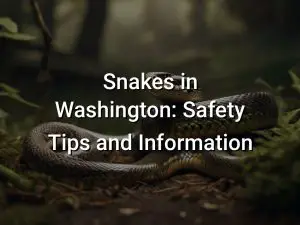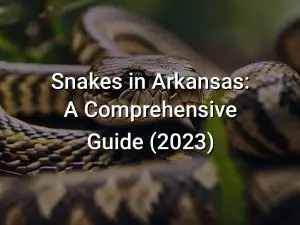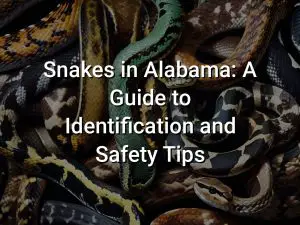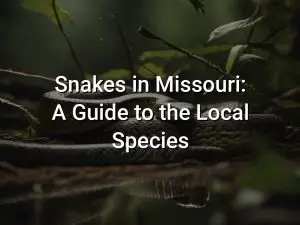Snakes in New Jersey: Identification and Safety Tips
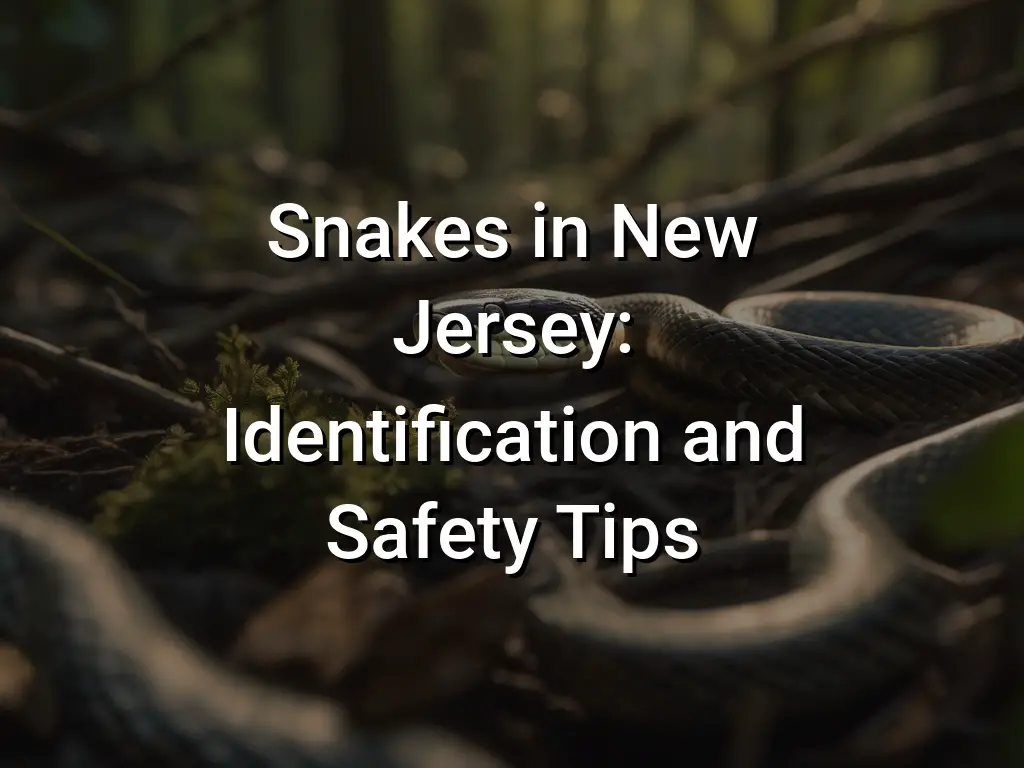
Are you curious about the snakes that inhabit the state of New Jersey? Whether you’re a nature enthusiast or simply want to stay informed for safety reasons, this article is for you! New Jersey is home to a variety of snake species, each with its own unique characteristics and habitats.
In this article, we’ll provide identification tips and safety precautions for the top 10 snake species found in New Jersey, including the Garter Snake, Northern Water Snake, and Timber Rattlesnake. So join us as we explore the world of snakes in the Garden State!
Quick Links
Garter Snake
The garter snake is one of the most common snakes found in New Jersey. It is a non-venomous snake and is easily identifiable by its long and slender body, with a distinct pattern of stripes running along its back and sides.
Garter snakes are usually brown or green in color, but can also have a mixture of yellow, red, or black. They are known for their ability to release a foul-smelling musk when threatened, which acts as a defense mechanism.
These snakes are typically found in grassy areas, gardens, and near bodies of water, such as ponds or streams. They feed on small animals such as insects, earthworms, frogs, and small rodents. Garter snakes are important for ecosystem balance as they help control populations of pests and serve as a food source for larger predators.
While garter snakes are generally harmless to humans, it is important to avoid handling or disturbing them, as they may bite if they feel threatened. If you encounter a garter snake, it is best to observe it from a safe distance and allow it to move away on its own.
- Avoid handling or picking up garter snakes
- Do not disturb their habitat
- Keep your yard clean and free of debris that may attract snakes
- Seal any cracks or holes in your home to prevent snakes from entering
- If you encounter a snake indoors, contact a professional snake removal service
By understanding and respecting the presence of garter snakes in New Jersey, we can coexist safely and peacefully with these fascinating creatures.
Northern Water Snake
The Northern Water Snake (Nerodia sipedon) is a common snake found in New Jersey. It is a non-venomous species that can grow up to 4-5 feet in length. It is often mistaken for the venomous water moccasin, but it is important to note that the water moccasin is not found in New Jersey.
The Northern Water Snake has a dark brown or black color with dark crossbands or blotches on its body. Its belly is usually lighter in color, ranging from yellow to orange with dark markings. It has a thick body and a flattened head, which is distinct from its slender neck. Its scales are keeled, meaning they have a ridge down the center.
These snakes are most commonly found near water sources such as ponds, lakes, rivers, and marshes, as they are excellent swimmers. They are active during the day and are known to bask on sunny rocks or logs near the water. They are opportunistic feeders and primarily eat fish, frogs, tadpoles, and small mammals.
If you encounter a Northern Water Snake, it is important to remember that they are non-venomous and generally not aggressive towards humans. However, they may bite if they feel threatened or cornered. It is best to observe these snakes from a distance and avoid handling them.
As with any wildlife, it is important to respect their habitat and not disturb or harm them. If you have concerns about Northern Water Snakes in your area, it is best to contact local wildlife authorities or pest control professionals for assistance.
Black Rat Snake
The Black Rat Snake, also known as the Eastern Rat Snake, is a common snake species found in New Jersey. It is a non-venomous snake that can grow up to 6 feet in length. The Black Rat Snake is known for its black coloration with white or yellowish bellies and its ability to climb trees.
These snakes play an important role in controlling rodent populations, as they primarily feed on small mammals like rats and mice. They are also known to consume birds, bird eggs, and other reptiles.
If you encounter a Black Rat Snake in New Jersey, it is important to remember that they are not aggressive and will typically try to avoid humans. However, if it feels threatened, it may hiss loudly, vibrate its tail, or bite as a defense mechanism.
To stay safe around Black Rat Snakes, it is best to keep a safe distance and not attempt to handle or disturb them. If you have a rat or mice problem, it is recommended to contact a pest control professional to address the issue rather than trying to attract or handle these snakes.
If you have a Black Rat Snake in your home or property and would like to remove it, it is advisable to contact a licensed wildlife removal expert who can safely and humanely relocate the snake.
Overall, the Black Rat Snake is a beneficial snake species that helps control rodent populations in New Jersey. By understanding and respecting these snakes, we can coexist with them and appreciate their important role in the ecosystem.
Timber Rattlesnake
The timber rattlesnake is a venomous snake species that can be found in New Jersey. It is the only venomous snake native to the state and is known for its distinctive rattling sound that it produces by shaking its tail. Here are some key characteristics and safety tips to keep in mind when dealing with timber rattlesnakes:
- Appearance: The timber rattlesnake has a thick body with a distinct pattern of dark brown or black crossbands on a lighter background color. It can grow up to 5 feet in length and has a triangular-shaped head.
- Habitat: Timber rattlesnakes are typically found in forested areas, including rocky hillsides, swamps, and marshes. They prefer areas with ample prey and suitable cover, such as fallen logs and rocky crevices.
- Behavior: Timber rattlesnakes are generally non-aggressive and will only strike if they feel threatened or cornered. They rely on their camouflage to stay hidden from predators and prey. When disturbed, they will often shake their rattles as a warning before striking.
- Diet: Timber rattlesnakes feed primarily on small mammals, such as mice and chipmunks. They are ambush predators and will patiently wait for prey to pass by before striking and injecting venom.
- Safety Tips: If you encounter a timber rattlesnake in the wild, it is important to remain calm and give the snake a wide berth. Do not try to handle or provoke the snake in any way. Keep children and pets away from the snake and alert park authorities or wildlife conservation agencies if necessary.
Remember, timber rattlesnakes play an important role in the ecosystem as predators and should be respected from a safe distance. By understanding their behaviors and taking necessary precautions, you can coexist with these fascinating creatures in their natural habitat.
Eastern Milk Snake
The Eastern Milk Snake is a non-venomous snake species that is commonly found in New Jersey. It is known for its distinctive pattern of reddish-brown or grayish-brown blotches, bordered by black bands, running down its back. The belly of the Eastern Milk Snake is usually a creamy white color, marked with black or gray checkerboard-like patterns.
These snakes are often found in wooded areas, grasslands, and near bodies of water, such as streams and marshes. They are excellent climbers and can frequently be spotted in trees and shrubs. The Eastern Milk Snake primarily feeds on small mammals, such as mice, voles, and shrews, as well as birds and their eggs.
Although the Eastern Milk Snake is non-venomous and generally harmless to humans, it can emit a foul-smelling musk and may bite if threatened or cornered. It is important to remember that snakes play a crucial role in maintaining ecological balance and should be respected and left undisturbed in their natural habitats.
If you encounter an Eastern Milk Snake or any other snake in New Jersey, it is best to observe from a safe distance and not attempt to handle or provoke the snake. If you have concerns about a snake on your property, it is recommended to contact a licensed wildlife professional for assistance in safely removing the snake.
Remember, snakes are an essential part of the ecosystem and should be appreciated for their role in controlling rodent populations and maintaining the balance of nature.
Northern Copperhead
The Northern Copperhead is a venomous snake that is found in certain regions of New Jersey. It is characterized by its copper-colored head and hourglass-shaped patterns on its body. The Northern Copperhead is a pit viper, meaning it has heat-sensing pits between its eyes and nostrils that enable it to detect warm-blooded prey.
The Northern Copperhead is primarily found in rocky areas and forests, where it can hide and blend in with its surroundings. It is most active during the warmer months and is known to hibernate during the winter.
Although the Northern Copperhead is venomous, it generally poses little threat to humans if left undisturbed. However, if approached or provoked, it may bite in self-defense. The venom of the Northern Copperhead is rarely life-threatening to adult humans, but it can cause pain, swelling, and other symptoms. If bitten by a Northern Copperhead, it is important to seek medical attention immediately.
To stay safe around Northern Copperheads and other snakes in New Jersey, it is recommended to avoid handling or attempting to capture them. Keep a safe distance if you encounter a snake and allow it to move away on its own. Keep your yard well-maintained, as snakes are attracted to tall grass and cluttered areas. Wear appropriate footwear when hiking or exploring areas known to have snakes, and be cautious when stepping over logs, rocks, or other obstacles where a snake may be hiding.
Remember, snakes play an important role in the ecosystem and should be respected and admired from a safe distance.
Eastern Kingsnake
The Eastern Kingsnake is a non-venomous snake species found in New Jersey. It is known for its distinctive black coloration with white or yellowish bands that form a chain-like pattern along its body. The Eastern Kingsnake can grow up to 3-5 feet in length.
This species is known for its ability to prey on other snakes, including venomous species such as copperheads and rattlesnakes. It is often referred to as the “King snake” because of this behavior. This makes the Eastern Kingsnake a beneficial snake to have in the ecosystem, as it helps control populations of venomous snakes.
The Eastern Kingsnake is primarily found in wooded areas, forests, marshes, and fields. It is a secretive snake that prefers to hide in underground burrows, logs, or rock crevices. It is also known to climb trees and swim in water bodies.
If you come across an Eastern Kingsnake in New Jersey, it is important to remember that it is a non-venomous snake and poses no threat to humans. However, it is best to observe and admire these snakes from a safe distance and avoid provoking or handling them. Snakes play an important role in the ecosystem and should be respected and protected.
Eastern Ribbon Snake
The Eastern Ribbon Snake is a non-venomous snake species that can be found throughout New Jersey. It is a slender snake with a distinctive striped pattern on its back, resembling the ribbon of a watch. The stripes are black or dark brown in color and run longitudinally down the body.
Eastern Ribbon Snakes are typically 20-30 inches in length and have a slender body shape, making them excellent climbers and swimmers. They are often found near bodies of water such as streams, ponds, and marshes, as they prefer habitats with a high humidity level.
These snakes primarily feed on small amphibians, fish, and invertebrates, using their quick speed and agility to catch their prey. They play an important role in controlling populations of pests and maintaining the balance of ecosystems.
When encountering an Eastern Ribbon Snake in the wild, it is important to remember that they are a harmless species and pose no threat to humans. However, like all wildlife, it is best to observe them from a distance and refrain from handling or disturbing them.
If you come across an Eastern Ribbon Snake in your yard or home, it is recommended to contact a professional wildlife control service for assistance with safely relocating the snake. Trying to handle or remove the snake yourself can be dangerous and may result in unnecessary harm to both you and the snake.
By understanding and respecting the Eastern Ribbon Snake and other snake species in New Jersey, we can coexist with these important members of our ecosystem and ensure their continued survival.
Eastern Hognose Snake
The Eastern Hognose Snake, also known as the Heterodon platirhinos, is a unique and fascinating snake species found in New Jersey. It is known for its distinct nose shape, which is upturned and resembles a pig snout.
The Eastern Hognose Snake can grow up to three feet in length and has a stout body with keeled scales. Its coloration varies but often includes shades of brown, gray, and black, with blotches or spots along its body. Some individuals may also have dark, leopard-like markings.
This snake species is primarily active during the day and is commonly found in sandy or loamy habitats such as pine barrens, meadows, and coastal areas. It is an excellent burrower and may occasionally be found underground or hiding beneath vegetation.
The Eastern Hognose Snake is not venomous and is generally harmless to humans. When threatened, it may exhibit a series of defensive behaviors. It may flatten its neck to appear larger, hiss loudly, and even strike with a closed mouth. However, it rarely bites, and even if it does, the bite is non-venomous and causes no harm.
One unique behavior of the Eastern Hognose Snake is its tendency to play dead when threatened or disturbed. It will often roll onto its back, open its mouth, and emit a foul odor to mimic the appearance and smell of a dead snake. This is an adaptation to deter potential predators.
If you encounter an Eastern Hognose Snake in the wild, it is best to appreciate it from a distance and let it go about its business. The Eastern Hognose Snake plays a valuable role in the ecosystem by controlling rodent populations. It is protected by state law in New Jersey, so interfering with or harming these snakes is illegal.
Remember, snakes, including the Eastern Hognose Snake, are important members of our natural environment and should be respected and admired for their unique characteristics and ecological roles.
Eastern Worm Snake
The Eastern Worm Snake is a small, non-venomous snake that can be found in New Jersey. It is one of the smallest snake species in the state, typically growing to be around 7-10 inches in length. Despite its name, the Eastern Worm Snake is not actually a worm, but resembles one due to its slender, cylindrical body and smooth, shiny scales.
Eastern Worm Snakes are typically brown or gray in color, with a pink or reddish belly. They have a blunt head and a pointed tail, which they use for burrowing into the soil. These snakes are commonly found in wooded areas, gardens, and damp, moist environments where they can easily find worms, slugs, and other small invertebrates to eat.
Eastern Worm Snakes are docile and non-aggressive, and they will typically try to avoid confrontation with humans. If threatened, they may curl up into a tight coil and release a foul-smelling musk as a defensive mechanism. However, their small size and secretive nature make them difficult to spot in the wild.
While Eastern Worm Snakes are harmless to humans, they can still be beneficial to have around. They help control populations of pests like slugs and worms, which can be damaging to gardens and crops. If you come across an Eastern Worm Snake, it’s best to leave it alone and let it go about its business.
Remember, snakes play an important role in our ecosystem and should be respected and appreciated from a safe distance. If you encounter any snake in New Jersey, it’s always a good idea to familiarize yourself with their identification and safety tips to ensure a peaceful coexistence.
Conclusion
Encountering snakes in New Jersey can be a common occurrence, but it’s important to know how to identify them and stay safe. By understanding the different species and their behaviors, you can have a better understanding of their potential threats and how to avoid them.
Remember to always give snakes their space and not approach or provoke them. If you come across a snake, stay calm and slowly back away. Keep children and pets supervised and on a leash when in snake habitats. By being aware and taking precautions, you can enjoy the outdoors in New Jersey while minimizing the risks associated with snakes.



